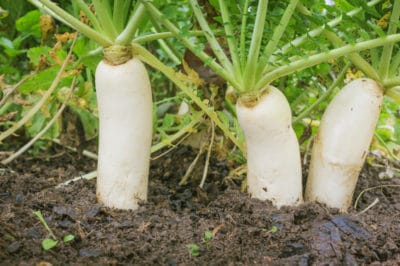About the Daikon Radish
Daikon radishes aren’t immediately recognizable as a radish if you’re thinking of a spicy-tasting, round, red globe to eat raw in salads. First, the daikon is white. Second, it’s shaped more like a carrot. Third, it can grow quite large. The flavor is mild, with just a hint of bite. Finally, daikon is one of the radishes that can be served in cooked form.
What’s in a Name?
Native to southeast Asia, the name daikon means “big root” in Japanese. You’ll see daikon radishes all over the Orient as well as India. It is used in many oriental cuisines. In the US, where it is called “oilseed radish,” the daikon radish is more likely to be commercially grown as a fallow crop to prevent soil compaction.
Daikon Varieties
In addition to the large white daikon radish, there are several other varieties. Not all are named.
- Chinese or Cantonese daikon may be either the more familiar white form or a version that is light green in the top of the root.
- Korean daikon is pale green in the top half and is shorter and wider.
- Watermelon radish is fuchsia inside and green outside.
Sowing Daikon Seeds
Like all radishes, daikon likes cool temperatures, although the Chinese variety can tolerate higher temperatures. It can be sown in spring or early fall. In the spring it should be sown four to six weeks prior to the expected last frost date. Plant seeds about ½ to one inch deep. Plant slightly deeper as weather becomes warmer.
Soil for Daikon Radishes
Like all radishes, daikon likes lots of phosphorus and not too much nitrogen. Use aged manure, leaf mulch or compost to add humus plus bone meal or rock phosphate. If growing to eat, loose friable soil is best so the roots have room to grow. Your soil must be at least 20 inches deep. For soil improvement, the texture of the soil is less important.
Daikon for Soil Improvement
You can take advantage of the daikon’s thick, long root if you have heavy clay or compacted soil. Let them grow until well past the eating stage. They’ll be too tough for human food, although chickens and farm animals like them. However, they’ll leave holes and “breathing space” in the area where they grew, which improves the soil.
